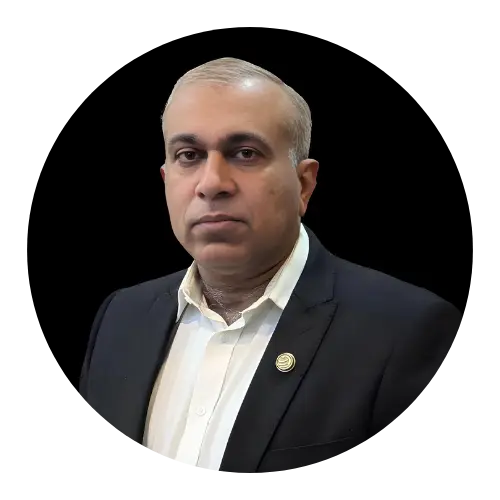Take a comprehensive look into the current challenges and emerging opportunities within Pakistan’s telecom industry.
With increasing taxation and shrinking revenue pools, telecom operators are under immense pressure to find innovative solutions that can sustain their businesses and expand connectivity, especially to remote and underserved areas. The discussion explores how new technologies and digital services can reshape the industry landscape.

Zulfiqar Mehdi, a strategic technology executive with over 30 years of experience in communication and IT, leads this insightful conversation. As a key figure at WorldCall, a leading telecom- and multimedia-service provider of Pakistan, Mehdi brings deep knowledge of project and R&D management, and a clear vision for driving innovation within a highly competitive market. His expertise offers valuable perspectives on how traditional telecom models are evolving to meet modern demands.
Drawing on their extensive experience, WorldCall focuses on leveraging digital transformation to address connectivity challenges and create new revenue streams, highlighting the critical role of collaborative efforts between telecom operators and ISPs to build sustainable and scalable telecom ecosystems in Pakistan.
Dive the global telecom experience with us in a new podcast interview about the Pakistan’s telecom industry:
Anastasiya (Aipix):
Moving straight to the questions, I would love to hear your expert view on the broader telecom landscape in Pakistan’s telecom industry. I’ve heard that there are some issues, particularly connected with the average revenue per user continuing to decline. From your perspective, what is the current state of the telecom market in Pakistan, and what factors may contribute to this drop in ARPU?
Mehdi (WorldCall):
Your first question is very deep, and I’d like to go into some detail. ARPU is definitely one of the biggest factors to assess the market, but often we miss that it also links with market expansion. If ARPU is decreasing, it doesn’t always mean that overall revenue is decreasing.
For example, in my country, back in 1999-2000, the local call rate for landlines between different parts of the country was about $3. Now, in dollar terms, it’s less than a penny. So, while ARPU has dropped, usage has increased massively — back then, there were hardly a million users, and today, we have tens of millions.
Specifically for Pakistan, yes, ARPU has decreased, but if we look at some figures, in 2010-11, global ARPU was around $14, whereas in Pakistan, it was just over $2. Today, global ARPU is about $8, and Pakistan’s ARPU is almost $6.8. So, relatively speaking, the decline isn’t as severe as it seems.
The main problem started when telecom companies focused mainly on infrastructure, seeing themselves only as infrastructure providers. They focused on building the network but didn’t invest in alternative revenue streams. It’s like building a road — you invest heavily, but you don’t earn directly from the road; income is indirect.
So, if telecom companies just keep laying infrastructure without monetizing other services, they will naturally lose ARPU and market share, which is what’s happening now.
Anastasiya:
Do telecom companies have plans to introduce innovative services or diversification strategies to address this?
Mehdi:
That’s a well-known strategy. However, in Pakistan, the sector has mostly been reactive. After privatization in the late ‘90s and early 2000s, revenues were so high that investors weren’t interested in value addition — they just relied on selling SMS and minutes.
The real challenge came with the introduction of 3G and 4G around 2013-14. Services like Skype and others started causing a major churn in revenue. Unfortunately, the telecom operators didn’t realize this impact immediately.
It wasn’t until very recently, around 2022-23, that real efforts to diversify began — driven largely by startups rather than telecom operators themselves. These startups had applications and sought platforms. Now, telecom infrastructure providers are collaborating with application providers, especially in sectors like agriculture, which has huge potential in Pakistan.
Anastasiya:
Could you share your view on the state of telecom infrastructure in Pakistan, particularly fiber optics and mobile networks?
Mehdi:
Pakistan was actually among the first countries to adopt new technologies. We had fiber optic cables installed as early as 1988-89 for national connectivity. Since then, fiber deployment has increased massively.
Pakistan is a large country — comparable in size to Germany or France. We have over 200,000 kilometers of fiber optic cable laid. Of that, 75,000 km is long-haul fiber, and the rest is metro fiber, covering cities multiple times over.
Almost all of this fiber is active, and we are already feeling the pressure of high demand.
Regarding mobile networks, Pakistan currently has about 190 million mobile users with a penetration rate of 78%, which is quite decent. Broadband penetration is about 57%.
Pakistan connected to the international internet via fiber in 2000, which marked a big boost for the sector after privatization.
Back in 2000, there were just 300,000 mobile users, and today we have around 120 million. Interestingly, landline users have not increased since 2000, despite population growth — in fact, landline use has shrunk.
For the last few years, growth has slowed significantly, possibly due to political and economic challenges.
For example, Pakistan was the first country to adopt WiMAX wireless broadband technology in 2007, even before ITU standards were formalized. But over the last 5-7 years, broadband speeds and growth have been stagnant.
Low ARPU means no one is ready to invest. After privatization, margins were high and profits significant, but the government imposed heavy taxes on telecom operators. At first, these taxes were manageable, but as ARPU shrank, taxes kept increasing.
Now, every telecom operator, regardless of size, is struggling to earn profits. For instance, Telenor, a Scandinavian group, has pulled back from Pakistan, citing market difficulties.
So, the major reason telecom companies struggle to survive is that taxation has been increasing while ARPU is decreasing. Now, they are just barely surviving.
Anastasiya:
Oh gosh, I see. Thank you so much for that insight. Before we move on to possible solutions in this market, can you please share some news or progress regarding satellite communication solutions in Pakistan? Given that Pakistan is a large country with diverse geography, satellite might be a strong solution for reaching rural areas without relying on terrestrial infrastructure.
Mehdi:
Absolutely. I would like to highlight two regions in Pakistan which are particularly challenging from the telecom infrastructure perspective. The first is the northern side, mostly the Himalayas. These areas are hard to reach, with scattered populations, making it an unattractive business proposition for telecom operators because investments are very high, but the population density is low. Also, the terrain and weather conditions are harsh.
The second region is Balochistan province. It covers over one-third of Pakistan’s land area but has less than 10% of the population — roughly 7 or 8%. This huge area with sparse population is very underserved. Some places have no roads, no electricity, and the living conditions are like a thousand years ago. Satellite communication is truly needed in these parts.
There have been some satellite providers offering services, like the Korean KT group and IDirect, but their satellite terminals were very expensive and unaffordable for most people in those areas. Currently, our biggest hope lies with Starlink. The government is already engaged with them and has provided necessary permissions. They plan to launch services by the end of this year, which could be a real game-changer.
Anastasiya:
Before we dive deeper into services, could you share with us WorldCall’s role in Pakistan’s telecom market for those who may not be familiar?
Mehdi:
WorldCall is a very old company with a rich history. We started as a long-distance interconnect operator, authorized by the government to bring international traffic into Pakistan. That was our core business initially.
Over time, we expanded into other services. One major venture was wireless local loop technology, aimed at covering the gaps where laying traditional copper local loops was too expensive. We installed wireless local loop infrastructure nationwide and also launched wireless broadband using CDMA technology over the same frequencies.
While our plans have always been ambitious, the company has faced ups and downs, including limited client growth. The long-distance business is still operational but challenged by market shifts. I joined WorldCall recently, hoping to bring change, and I’m still working toward that goal.
Anastasiya:
That’s great to hear! Speaking of change and transformation, what are WorldCall’s plans for introducing new digital services to the telecom market? For example, video surveillance as a service is becoming quite well-known.
Mehdi:
Currently, simply laying infrastructure and selling minutes or megabytes is no longer sustainable. Telecom operators barely survive. So, investing more in the same old services doesn’t make sense.
At WorldCall, we are shifting focus toward software and IT services. Recently, we acquired some startups with promising products, incubating their ideas and turning them into marketable solutions.
We’ve entered fields like AI — which everyone is into — blockchain technology, and banking software. For blockchain, we’ve established a nationwide network with a couple hundred nodes and conducted pilot projects like distributing food vouchers using blockchain. Banking software is another area we’re actively developing.
Gradually, WorldCall is moving away from just telecom networks toward broader IT solutions.
Anastasiya:
Thanks for sharing that. I’m particularly interested in video surveillance as a service, especially from the end user perspective. Which sectors show the most demand for this service? Is it mostly B2B or B2C?
Mehdi:
Video surveillance is actually what connected Aipix with WorldCall. When I started exploring its applications, I realized market demands vary greatly by country. You can’t have one-size-fits-all solutions in Pakistan, especially considering our internal security challenges.
The government mandates surveillance in many places. All government buildings must have cameras, commercial buildings are required to install them, and large-scale projects are underway like the Border Surveillance and Safe City or Smart City initiatives. These projects aim to cover entire cities with cameras and backend systems for vehicle recognition and incident tracking.
The potential in video surveillance is huge, but there is a significant challenge: everyone tries to build their own independent networks. Safe City projects have their own data centers and fiber networks, banks record locally, even households have multiple cameras with local recording.
This fragmentation leads to increased costs because instead of sharing infrastructure and resources, every entity builds its own end-to-end system. It’s like every street having a separate internet provider — very inefficient.
This is the biggest challenge. There’s a lot of potential, but the market is not yet ready to harvest it effectively.
Lado:
What do you think about the potential for Pakistani operators and ISPs offering video surveillance services? Earlier, we discussed decreasing ARPU and how many B2B clients manage their own surveillance and storage. Based on our experience with telecom companies, a typical service approach is to say to B2B clients: “You spend a lot on storage and maintaining cameras — let us handle it. We’ll tape everything, maintain the system, and you just pay a monthly or annual subscription, which we can bundle with your internet.” This seems like a perfect solution for Pakistan’s telecom industry. What’s your take?
Mehdi:
Let me break down the challenges so we can define the problem clearly. Video surveillance isn’t just one thing — it involves multiple components. You need sensors or cameras on one end, infrastructure to carry the bandwidth, and a data center for storage.
The key challenge is bandwidth. Video requires very high bandwidth, so we can’t rely on radio frequencies or mobile network bandwidth alone. It must move over fiber.
Even 5G networks need extensive fiber penetration into every street corner to support their hotspots. So fiber infrastructure is absolutely essential.
In Pakistan, fiber is mostly owned by ISPs. But data centers tend to be owned by telecom operators, not ISPs. This creates a problem: if either storage or fiber access must be paid for separately, the service becomes too expensive.
Only ISPs who have built their own data centers and own fiber infrastructure can offer video surveillance as a value-added service on top of internet connectivity.
Another point is pricing. Mobile ARPU in Pakistan is very low — around 70 to 80 cents per month — but broadband ARPU ranges from $10 to $20, which is more reasonable. Broadband customers are already paying for multiple services — smart TV, video on demand, etc. So broadband infrastructure is ideal for transporting video surveillance data as well.
There is at least one ISP successfully running a video surveillance business in Pakistan. On the server side, they don’t use complex analytics software. For example, a typical consumer with two home cameras wants simple replay, not facial recognition or deep analytics.
So their servers act as blind storage, while cameras themselves handle smart features like motion detection, which helps reduce bandwidth and storage needs by only recording when motion is detected.
In summary, for any video surveillance project in Pakistan, you must partner with a service provider who owns both a data center and fiber infrastructure. Without both, the service becomes unaffordable.
Anastasiya:
That makes sense. Do you see a brighter future with more collaboration between ISPs and telcos to provide such services? You mentioned an ISP that has launched video surveillance successfully — is there potential for others to follow?
Mehdi:
Definitely. I’m currently engaged with a specific telecom operator who is unique because they have exclusivity in one zone of Pakistan, which no other operator has. They provide mobile, landline, broadband, fiber-to-the-home, and even own terrestrial and international fiber interconnects.
Although a small operator, they have a full ecosystem, including their own data center. I believe if we can build a business model for video surveillance as a service with them, it will succeed.
I’m also trying to engage with another operator who has a data center and fiber infrastructure. I have a meeting with them soon and see interest.
But again, this would be a value-added service, and pricing is critical. Currently, the price tag is about $2 per month per camera, so we must consider how much revenue can realistically be generated.
I’ve also thought about introducing smart home products, like Google Nest or Ring doorbells. Google Nest’s subscription costs around $8 to $10 per month, on top of internet charges. Such smart services could add real value and increase revenue potential.
Without smart features, just recording and storage alone doesn’t offer much business potential.
This kind of product shows huge potential — being able to talk to visitors remotely, for example.I think the future could definitely focus more on these smart, interactive services.
The telecommunications industry is evolving rapidly worldwide, and Pakistan is no exception. Despite facing infrastructure challenges and market pressures, the sector is exploring new technologies and innovative solutions to meet growing demands. The integration of advanced digital services, improved connectivity options, and collaborative efforts among providers holds promise for a more connected and efficient future.
As the landscape changes, staying adaptable and embracing innovation will be key to unlocking the full potential of telecom services.





